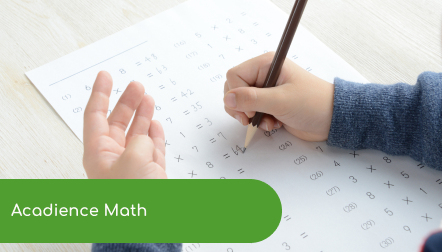Assessments
Acadience helps teachers understand where their students are at—regardless of teaching style or student background. Each assessment is carefully designed to provide specific performance measures and recommend concrete interventions to help students improve.Top Learning Assessments

Acadience Reading K–6 helps educators monitor reading proficiency across a variety of educational settings. By detecting when students need extra support, Reading K–6 helps teachers improve student outcomes.

Acadience Math offers universal screening to identify students in need of additional support, monitor progress for at-risk students, and measure the effectiveness of school-wide support systems.

Acadience Reading Diagnostic was built from the demand for diagnostic reading assessments that are cost-effective, time-efficient, reliable, valid, and linked to Acadience Reading K–6.

Acadience Reading
Acadience Reading is a set of standardized indicators of literacy skills. Designed for universal screening and progress monitoring, Acadience Reading can help prevent reading failure and improve reading outcomes for students in grades K–8.
- Acadience Reading Pre-K: PELI
- Acadience Reading K–6
- Acadience Reading 7–8
- Acadience Reading Diagnostic
Acadience Math
Acadience Math is available for grades K–6. The measures are brief and easy to administer, allowing educators to monitor student progress and provide extra support exactly when and where each student needs it most.

Assessment FAQs
Q: Why is Retell a required part of Oral Reading Fluency (ORF) in Acadience Reading?
A: An in-depth response can be found in our position paper, Why is Retell a Required Part of ORF in Acadience Reading?
Q: Why are the sixth-grade benchmark goals for Acadience Reading lower than the fifth-grade goals?
A: The difficulty level of the passages used for ORF and Maze changes by grade, so composite scores, and benchmark goals can’t be directly compared across grades. The difficulty level of the passages increases by grade in a roughly linear fashion. However, student performance increases in a curve, with the most growth occurring in the earlier grades, and slower growth in the upper grades. Between fifth and sixth grade, the difficulty level of the materials increases at a faster rate than student performance, so benchmark goals are lower in sixth grade than in fifth.
Q: Why doesn't Letter Naming Fluency (LNF) have benchmark goals?
A: LNF has always been used as an indicator of risk rather than an instructional target. This is also why progress monitoring materials are not provided for LNF. The Reading Composite Score includes LNF and provides the best indicator of risk. Since the risk indicator comes from the composite score and LNF does not assess an instructional target, there is no need for a benchmark goal for LNF.
Q: Is LNF a measure of Rapid Automated Naming (RAN)?
A: LNF is not a direct measure of RAN, although RAN is likely a component skill that contributes to fluency in letter naming once students know the names of the letters. Tasks that are direct measures of RAN differ from LNF in the following ways:
- RAN tasks typically involve the timed naming of a small number of familiar items arranged in a grid with each of the familiar items repeated in random order. For example, a common RAN task contains five rows in which five items (letters, numbers, colors, shapes) are displayed in left-to-right serial fashion and repeated randomly in each row. In contrast, LNF uses all 26 upper-case and lower-case letters in a stratified-random order and assesses a student’s knowledge of letter names as well as fluency in naming them.
- RAN tests use items that are familiar to the student. On LNF, students may or may not know the name of some or all of the letters.
Acadience Reading now includes a measure of RAN. Visit the Acadience RAN page to learn more.
